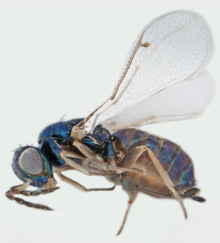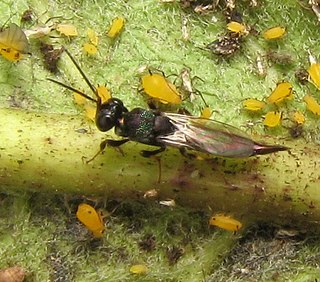Loading AI tools
Superfamily of wasps From Wikipedia, the free encyclopedia
Chalcid wasps (/ˈkælsɪd/, from Greek khalkos 'copper', for their metallic colour)[1] are insects within the superfamily Chalcidoidea, part of the order Hymenoptera. The superfamily contains some 22,500 known species, and an estimated total diversity of more than 500,000 species, meaning the vast majority have yet to be discovered and described.[2] The name "chalcid" is often confused with the name "chalcidid", though the latter refers strictly to one constituent family, the Chalcididae, rather than the superfamily as a whole; accordingly, most recent publications (e.g.,[2]) use the name "chalcidoid" when referring to members of the superfamily.
| Chalcid wasp Temporal range: | |
|---|---|
 | |
| Omphale cornula | |
| Scientific classification | |
| Domain: | Eukaryota |
| Kingdom: | Animalia |
| Phylum: | Arthropoda |
| Class: | Insecta |
| Order: | Hymenoptera |
| Suborder: | Apocrita |
| Infraorder: | Proctotrupomorpha |
| Superfamily: | Chalcidoidea |
| Families | |
|
See text | |




Most chalcid wasps are parasitoids of other insects, though other life styles are known, with the herbivorous fig wasps acting as pollinators. Various species are used as biological pest control agents or in scientific research.
Chalcidoids are generally small wasps, averaging 1.5 mm in length and usually being less than 3 mm. The body is often metallic in colour. The wings may be developed, reduced or absent. When the wings are developed, they have reduced venation or sometimes none at all.[3]
However, the group is morphologically very diverse. Chalcidoids range in size from up to 41.7 mm long (females of the pelecinellid Doddifoenus wallacei, this length includes the ovipositor[4]) to merely 0.13 mm long (males of the mymarid Dicopomorpha echmepterygis). Various lineages have convergently evolved features such as enlarged femora, enlarged acropleura, reduced numbers of antennal and tarsal segments, reduced wings or reduced wing venation. Some have significant sexual dimorphism: male fig wasps are "turtle-like fighting machines" that are very different to the females, while males of the aforementioned D. echmepterygis lack eyes, ocelli, mouthparts, antennal flagella or wings.[2]
Most chalcidoids are parasitoids, their hosts including insects, spiders, ticks and mites, pseudoscorpions and even gall-forming nematodes. Some species parasitise a wide range of hosts, while others have a narrow host range. They attack host life stages ranging from eggs to adults. The superfamily includes primary, secondary and tertiary parasitoids, both ecto- and endoparasitoids, and both solitary and gregarious parasitoids.[2][5]
There are also herbivorous chalcidoids within the families of Agaonidae, Epichrysomallidae, Eurytomidae, Eulophidae, Melanosomellidae, Ormyridae, Pteromalidae, Tanaostigmatidae and Torymidae. Agaonidae only develop within figs.[2][5][6]
Predation is exhibited by larvae of some Encyrtidae (prey on coccid eggs) and some Eurytomidae (prey on Cynipidae larvae).[5]
Chalcidoidea is one of the most important taxa of biological control agents. They are used to control pest insects in both natural and agricultural ecosystems.[2] Some herbivorous species are also used in biological control, such as the melanosomellid Trichilogaster acaciaelongifoliae for control of the weed Acacia longifolia.[5]
There are also chalcidoids that are agricultural pests themselves, mainly attacking plant seeds. Bruchophagus attack seeds of legumes (e.g. alfalfa), Systole attack seeds of Apiaceae used as spices (e.g. coriander) and Megastigmus attack seeds of Pinaceae grown in plantations.[5]
Females of family Agaonidae are important as pollinators of figs.[7]
Some chalcidoids, especially those in genera Trichogramma (Trichogrammatidae) and Nasonia (Pteromalidae) are model organisms in scientific research. They have been used to study sex determination, the influence of bacterial endosymbionts and the genetics of speciation.[2] The genome of moth parasitoid Copidosoma floridanum was sequenced as part of the i5K project.[8]
Chalcidoidea is a superfamily of Hymenoptera, whose family constituency is in constant flux, as new hypotheses of relationships are constantly being proposed and rejected; with the advent of molecular systematics, it seems that the future will see further revisions of the classification in use today.
There are fifty extant families recognized at present:
There are also three extinct families:
Of these families, at least five are known to be artificial groups (paraphyletic), and have been divided into several families. The most problematic, the Pteromalidae, has recently been split into 24 families, and Eupelmidae into three families.[9]
Seamless Wikipedia browsing. On steroids.
Every time you click a link to Wikipedia, Wiktionary or Wikiquote in your browser's search results, it will show the modern Wikiwand interface.
Wikiwand extension is a five stars, simple, with minimum permission required to keep your browsing private, safe and transparent.